Udinese captain and forward Kevin Lasagna finished off the 2019/20 Serie A campaign with 10 goals in 36 appearances, establishing himself as the top-scorer for the Friulani.
This tactical analysis and scout report breaks down the tactics and offensive contributions of Lasagna at Udinese. With the use of footage, heatmaps and data, this analysis highlights Lasagna’s strengths in open-field situations while pointing out his limitations when it comes to supplying key passes to his teammates.
Overview
Lasagna debuted in Serie A when he joined Udinese in the 2017/18 season. Now 28 years old and arguably entering the prime time of his footballing career, Lasagna has recently surpassed 100 Serie A appearances and netted a total of 28 goals in three years. Predominantly a left-footed player, Lasagna has showcased unique physical abilities despite not being excessively strong on paper: he stands at 181 centimetres (5’11” feet) and weighs 80 kilos (176 pounds).
In Udinese’s 3-5-2, which turns into a 5-3-2 while the friulani are out of possession, Lasagna occupies one of the front two positions, usually next to Stefano Okaka or Ilija Nestorovski. The image below, taken from the Udinese-Sampdoria match in July, shows Lasagna’s typical position in manager Luca Gotti’s system.
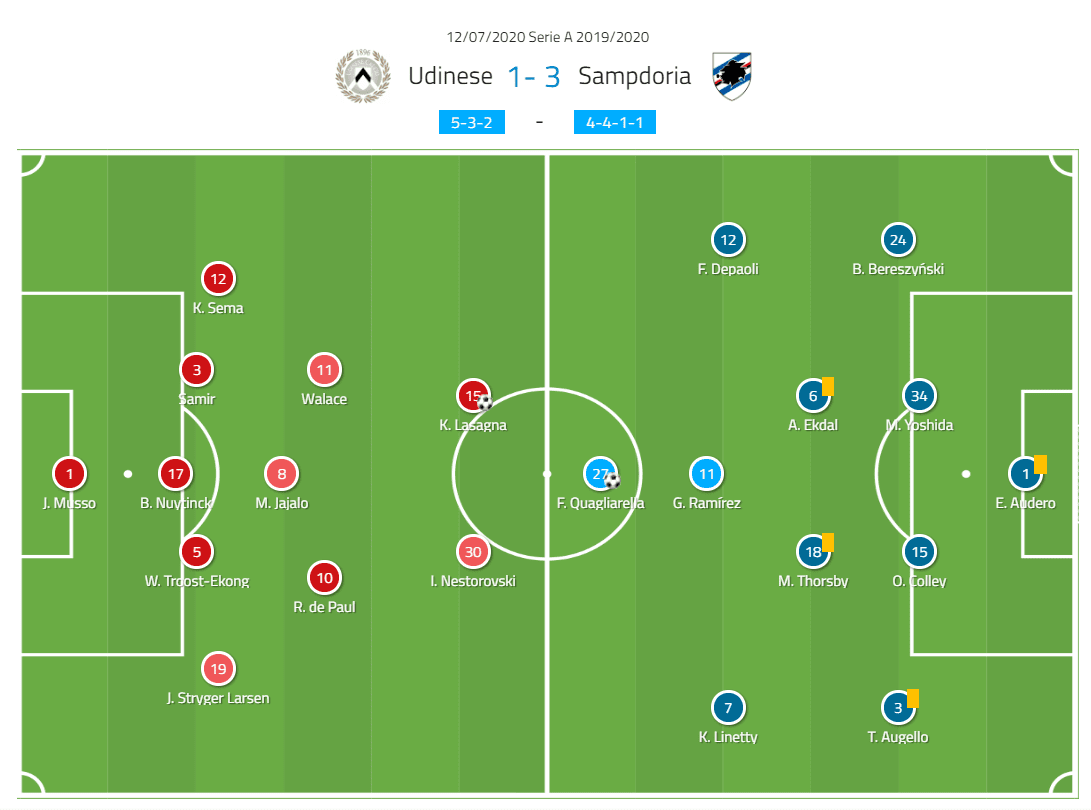
In 2018, Lasagna received his first national team call-up by Italy’s manager Roberto Mancini and has recorded four appearances since. In Mancini’s 4-3-3 system, he can occupy any of the front three positions, on either wing or as a centre-forward.
Positioning on and off the ball
Lasagna’s heatmap shows that he does not linger in the same areas for 90 minutes. His tendency to roam across, as well as up and down, the pitch has to do with his positional duties on and off the ball for Udinese.
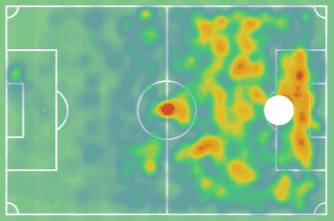
When Udinese are in possession, Lasagna keeps a high position, often sitting on the deepest defender. By doing this, Lasagna stretches the opponent’s defensive line, as the centre-backs are worried about getting too tight on the Udinese forward; they want to avoid getting caught in a footrace with him should the ball be hit over the top. Thus, by sitting on the opponent’s deepest defenders, Lasagna causes pockets of space to open underneath the defensive line, which can be exploited by his teammates.
The picture below shows how Lasagna is often found in between the opponent’s centre-backs. Notice the pockets of space that originate just underneath the Genoa’s defensive line as the Genoa’s centre-backs are reluctant to step too tight on a pacey player like Lasagna. Doing so would in fact expose areas of the pitch behind their back, which is an unwise decision to make when marking the quick Udinese forward.
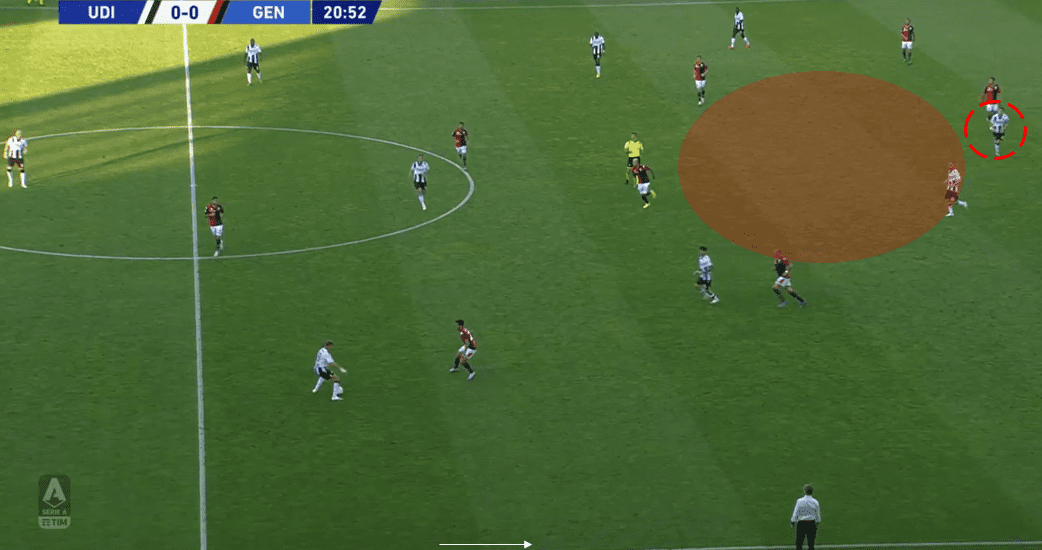
Due to Udinese’s tendency to maintain a compact block rather than applying high pressure on the opponent while out of possession, Lasagna has the job of occupying one of the opponent’s central midfielders during the defensive phase. His attacking partner, usually one between Okaka and Nestorovski, assumes a similar position. This is because Udinese prefer taking the opponent’s midfielders away from their build-up phase while being okay with letting the opponent’s centre-backs initiate the play.
As we can see in the picture below, taken from Udinese’s home game against Sampdoria, Lasagna does not step high on the defender that is carrying the ball up the pitch. Instead, he stays close to Udinese’s midfield line of three and marks Sampdoria’s midfielder Morten Thorsby, letting centre-back Maya Yoshida make the decisions on the ball for the guests. In other words, Lasagna contributes to keeping his side compact by maintaining a short distance between Udinese’s attacking and midfield lines.
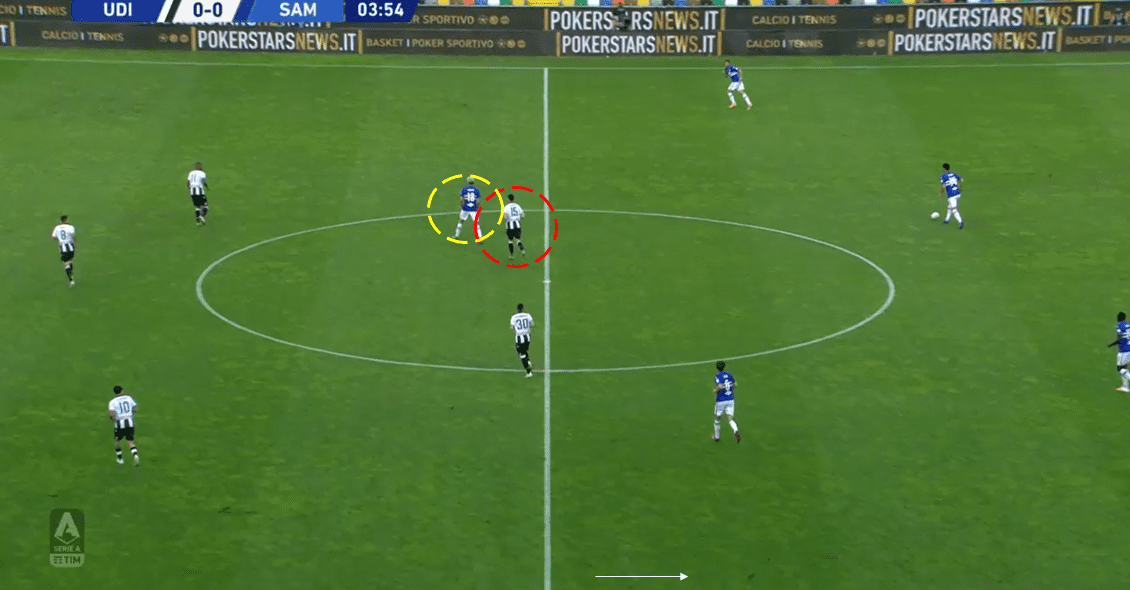
Unique athletic skills
Lasagna’s athleticism is what sets him aside from most Serie A forwards. He combines physical strength and explosiveness with a unique ability to release powerful shots while running at full speed.
It is indeed his acceleration that makes a difference in open-field situations, where defenders struggle to keep up with his fast pace. The picture below displays the perfect circumstances for Lasagna to take off on the run: as his teammate is facing forward with the ball at his feet, Lasagna picks up speed and becomes a threatening passing solution by attacking the space behind the opponent’s defensive line.
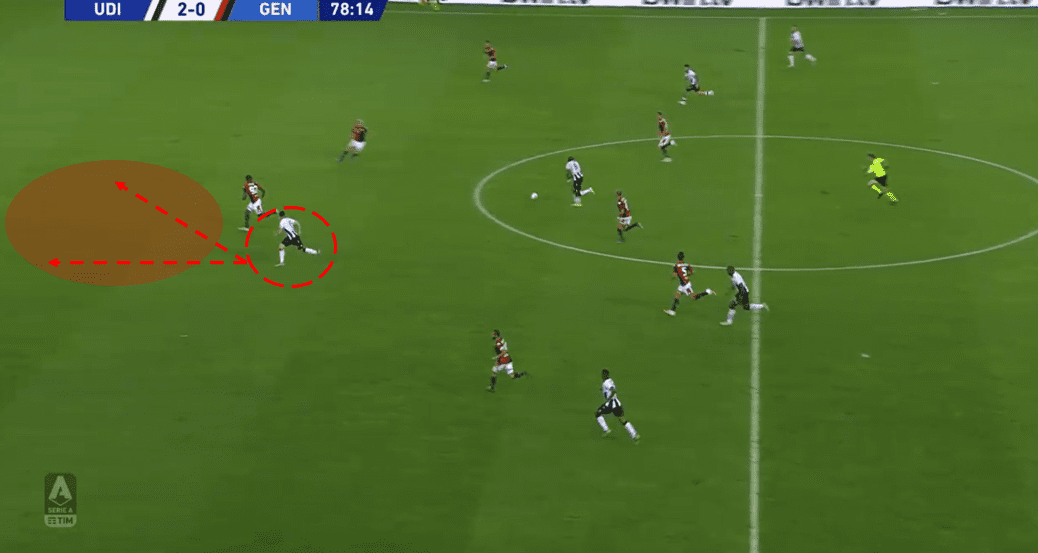
A master of attacking vacant spaces behind the opponent’s defensive line, Lasagna wants his teammate to find him on the run to make sure he can express his strengths to the fullest. The picture below shows him visibly asking his teammate to deliver the ball in the space behind SPAL’s defensive line. Notice how, while running, Lasagna extends his arm to point toward the area that he plans to attack with his fast movement. On this occasion, he ends up receiving the ball and scoring the third goal for what will be Udinese’s 3-0 away victory.
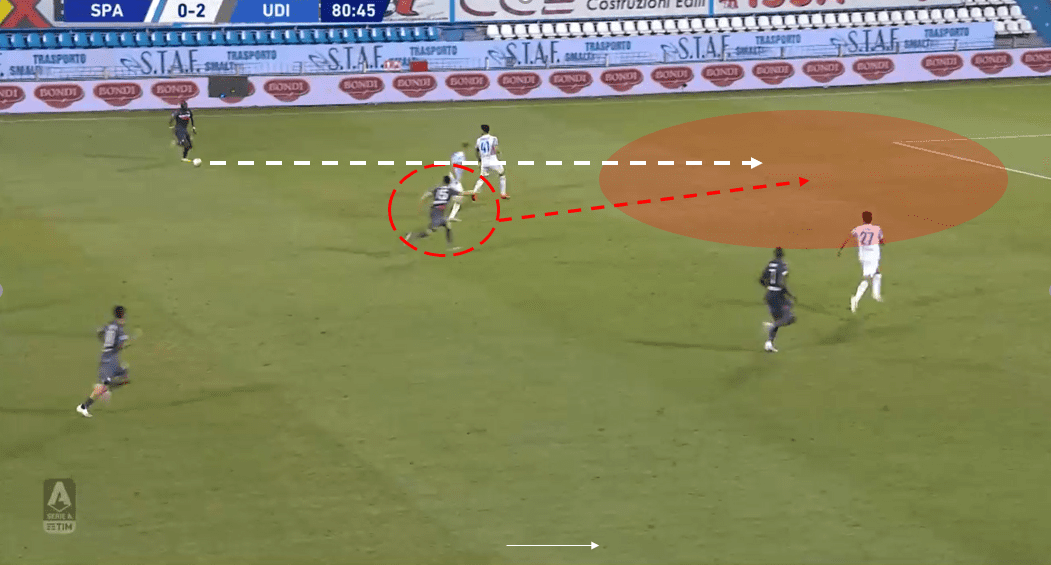
Lasagna’s teammates are aware of his athletic gifts, and that is why they do not hesitate to launch him into vacant spaces whenever they see the potential for one-versus-one situations in the final third of the pitch. This happens even when the service for Lasagna may not seem the most obvious passing option.
In the pictures below, captured during Udinese vs Sampdoria, Udinese’s right wing-back, Jens Stryger Larsen (left image), has the ball well inside his own half. He picks up his head and recognizes that Lasagna is battling with Sampdoria defender Yoshida further up the pitch (right image). Even though this pass would be a hard one for Lasagna to deal with, Stryger Larsen puts his head down and floats a long ball for his captain, who is now left challenging a difficult ball in the air with Yoshida.

With his arm, Lasagna pushes away Yoshida while maintaining his balance: Lasagna’s stability is indeed another indication of his unique physical attributes, which often prevent defenders from easily knocking him off the ball. In this situation, Lasagna wins the one-versus-one aerial duel, picks up the ball and accelerates toward the opponent’s box, from where he releases a powerful shot with his left foot that gives Udinese the lead.
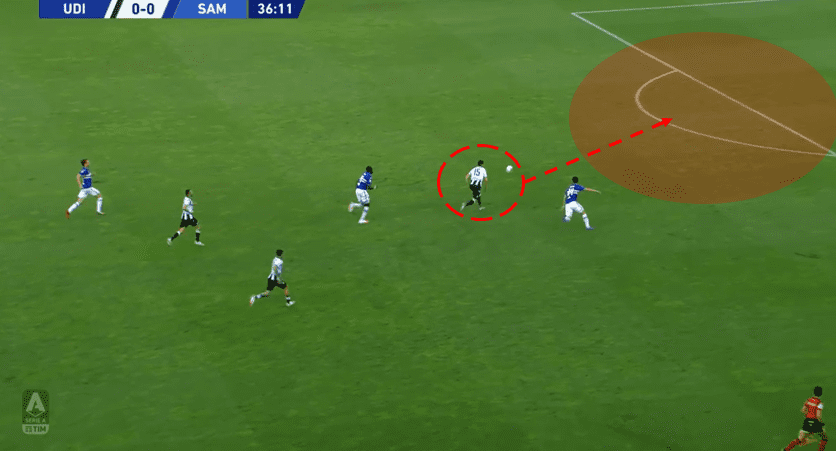
Lasagna has scored 10 goals in 36 matches this Serie A season, recording an impressive 0.33 goals per 90 minutes. Out of these 10 goals, Lasagna scored eight in transition or one-versus-one situations, where his pace turned out to make a difference. (The remaining two goals were a header against Atalanta and a shot from inside the box against AC Milan.)
Contribution during build-up
Lasagna does not participate much in Udinese’s build-up and is rarely seen taking up play-making duties for his side. When he does contribute to the play, he is mostly used as an outlet by his teammates when they need to release pressure from the back. On these occasions, Lasagna utilizes his strength to firmly plant his feet, shield the ball and lay it off to a teammate approaching from underneath. Immediately after, he sprints up the pitch and looks to attack vacant spaces with his pace.
The sequence below shows Lasagna doing exactly this kind of work against SPAL. Notice how, in the span of six seconds, Lasagna goes from holding up a defensive clearance in his own half to attacking the space behind SPAL’s centre-backs in the final third of the pitch.

Udinese’s desire to transition quickly from defence to attack with quick, vertical passes rather than through ball circulation is another reason why we rarely see Lasagna completing link-up passes or engaging in short combinations during a game. This team’s approach to the game reflects in Lasagna’s statistics about passing. He ranks third-to-last in total passes per 90 minutes among Serie A players with a minimum of 15 appearances this season, averaging only 16 passes per game. Below him stand only Lecce’s forward Gianluca Lapadula and Cagliari’s forward Giovanni Simeone.
Lasagna’s low passing rate is also visible in the amount of key passes that he completed during this 2019/20 campaign. He is fifth-to-last in key passes among the Serie A forwards, with 0.8 per 90 minutes. What is more, he only recorded one assist in 36 appearances this year.
This factor could raise questions about whether Lasagna would perform at a high level in a system that relies on ball possession to create offensive threats to the opponent’s goal. Since Lasagna has only played for Udinese in Serie A, such doubts remain open for debate.
Conclusion
Lasagna fits very well in Udinese’s system and style of play, which does not entail retaining too much of the ball, as suggested by the 44.8 percent of average possession, the fifth-lowest in Serie A. Instead, Udinese rely on their forwards’ athleticism to score goals. (Lasagna’s most-employed attacking partner, Okaka, is physically dominant as well.) Lasagna is a strong weapon thanks to his speed, recognition of the space behind the opponent’s defensive line and ability to keep the ball close to his feet while running at full speed.
There have been talks about Lazio and Napoli being interested in signing Lasagna. If the Udinese captain were to leave Udine, Simone Inzaghi’s Lazio seems like the most realistic fit as Lasagna is used to playing in a 3-5-2 system. What is more, Inzaghi needs more depth next season due to his side’s involvement in the UEFA Champions League. For his characteristics, Lasagna seems like a valuable attacking partner to Ciro Immobile in the Biancocelesti’s trademarked 3-5-2.





Comments